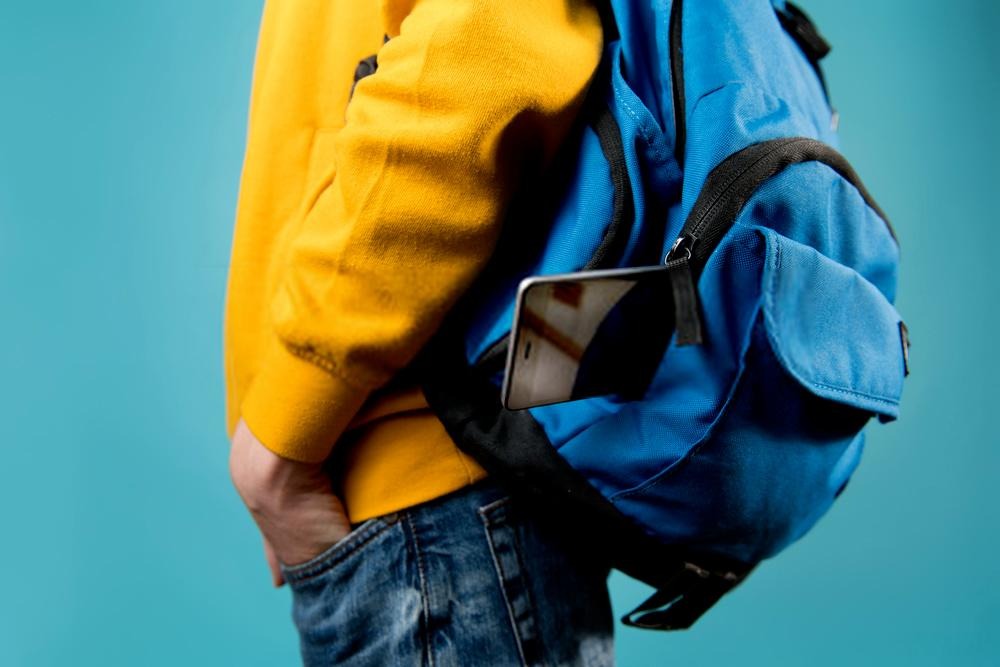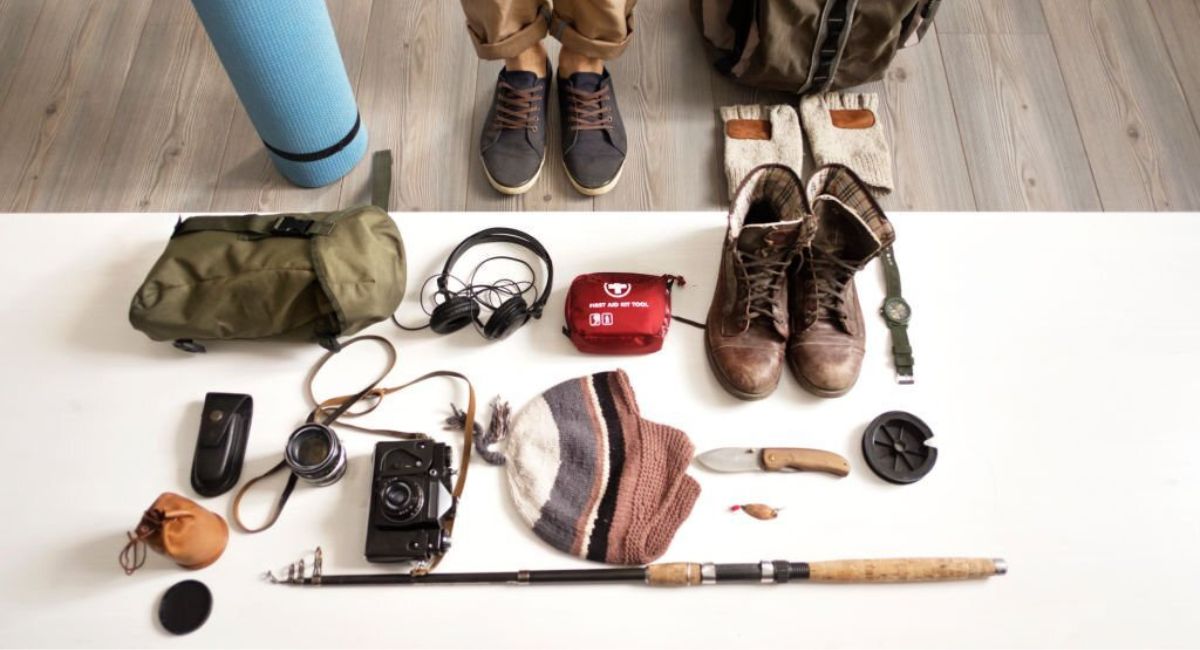Regardless of the type of washing you choose to make your backpack as good as new, the first operation you will have to carry out is to completely empty this bag of its contents.
This operation is essential both to prevent any objects stored inside it from being damaged when they come into contact with water, and because when you go to rub the fabric of the backpack to wash it some metal object could ruin it or even tear it off.

After you have emptied it of the largest and most bulky items, we recommend that you use a small battery-powered vacuum cleaner to remove any residual crumbs and dust inside.
All the objects that you usually keep inside the backpack you can put them in a container or in a plastic bag to put them back inside and you can also take advantage of the opportunity to clean something that is normally contained in the backpack.
Another operation you can do before washing concerns the treatment of stains.
You can use a degreaser or cleaner that you will need to spray on the stains and let it work for at least 30 minutes.
After this time, you can use a soft brush or an old toothbrush to easily remove stains from the fabric.
We strongly advise you not to use bleach as with a very high probability it will ruin the fabric of the hiking backpack.
If you don’t have a stain remover or a specific detergent available for stains, you can use a solution made of soap and water to apply directly to the stains.
How to hand wash a trekking backpack?
Let’s move on to the actual washing.
First you will need to fill a large basin, the bathtub, or the breakfast nook with lukewarm water.
It will be essential that you do not use hot water as this could discolour the fabrics.
Some very important aspects during the washing phase are the space available which must be sufficient to guarantee freedom of movement to easily wash the different compartments of the trekking backpack and to pay attention to any parts of the same for which the washing instructions recommend to not immerse completely in water.
After carrying out a first wash using only the water you filled, you can add detergent, taking care, however, that it is not a particularly aggressive product that could cause both skin irritation and damage or discoloration of everything or part of the backpack fabric.
If you are sure not to damage your hiking backpack you can immerse it completely in water and use a brush with soft bristles.
In reality, the best choice is to use the latter only where the dirt is particularly evident or where there are stains with encrustations while it is more convenient to use a soft cloth for ordinary cleaning.
If you are not sure that the fabric will not be damaged by the use of the brush, a valid alternative is the use of a sponge, soaked in water and detergent, with which to exert a slight pressure in the areas where the dirt is present to remove it easily.
At this point, if you realize that your best hiking backpack is clean, the washing is finished, and you can then proceed to rinse it under plenty of cold or lukewarm water to remove any residue of dirt and traces of detergent.
To decrease the time it takes for it to dry, you have to wring out the backpack so that as much water as possible is eliminated. During this phase you must be careful of the zips and any other metal parts that could damage the fabric of the backpack while it is being wrung.
How to clean a backpack in a washing machine?
What we have just examined is the hand washing mode of the trekking backpack, but nothing prevents your accessory from being machine washed.
Before proceeding with any operation, it is advisable to check on the label showing the washing instructions if it is possible to wash your trekking backpack in the washing machine.
In fact, some manufacturers do not recommend carrying out this type of washing because the fabric could be damaged due to too high temperatures.
Before moving on to washing, as seen previously for hand washing, empty the backpack of all its contents, taking advantage of it to clean even some of the objects that you usually put inside the bag.
Also in this case, use a small vacuum cleaner to thoroughly clean the residues of dirt and dust present in the inside folds of the backpack and to remove any food crumbs that have been inserted during use.
We remind you again to put all the contents of the backpack in a container or in a plastic bag in order to have them at hand when you have to put back all the objects that you usually have at hand inside the backpack. trekking.
Before inserting the backpack into the washing machine, it is advisable to first check the external parts to locate any dirt stains that must be treated differently or for which it is advisable to use a degreaser or detergent before washing in the washing machine.
You can wipe the outside of the backpack and the fabric part with a damp cloth to remove any dirt residue, treating the most stubborn stains with a mild detergent.
In this case, you can use any type of detergent that is not very aggressive by treating the part with dirt directly with a damp cloth or possibly with a brush that has not particularly hard bristles.
You can also use an old toothbrush, taking care not to force your hand too much to avoid tearing the fabric, rubbing it too vigorously.
If you do not want to use industrial detergents, a solution that you can prepare yourself with soap and water may also work; Regardless of the product you want to use for stain treatment, it must be left to act on the stains for at least 30 minutes before washing.
We reiterate the advice to remove, before placing the backpack in the washing machine, to remove the metal structure and any parts that can be detached.
Before starting the washing in the washing machine, carefully check the instructions on the label inside the backpack.
In fact, this will indicate the washing in the washing machine at what temperature it must be carried out to avoid damaging the fabric or discolouring it and which detergents can be used as they are not particularly aggressive.
In general, you should not find any contraindications to washing with this appliance since most of the trekking backpacks on the market are made of canvas or nylon fibre, materials that resist very well to this type of washing.
The best possible solution is to insert it inside an old pillowcase to prevent it from coming into direct contact with the metal parts of the washing machine door during washing.
Pour a small amount of detergent and detergent into the dispenser. Then set a washing cycle that does not include the use of hot but cold or lukewarm water, taking care to check the backpack during the spin cycle as being full of water and therefore heavy, it could cause the washing machine to move sideways.
At the end of the wash cycle, you can remove the backpack from the pillowcase and put it to dry.
The advice we give you is always to avoid the dryer and make sure it is placed outdoors instead.
In this way, a gradual and uniform drying will take place which will avoid some damp folds remaining which could also lead to the formation of mould. Once you are sure that your trekking backpack is completely dry, you can put the various objects back inside and leave again for an exciting excursion.
How to dry a backpack after washing it?
The last phase of washing consists in drying which must take place naturally, spreading it out in the fresh air, avoiding using the dryer.
This is because it ensures that the backpack dries gradually without any unpleasant odours left behind.
Preferably the backpack should be positioned upside down and with the zippers open.
Before using your hiking backpack again and storing the items you previously removed, make sure it is perfectly dry to prevent mouldy areas from forming with moisture.
At this point you can proceed with the preparation of the backpack before the actual washing.
With the help of a brush, you will proceed to remove any residual dirt on the fabric and then you can use a damp cloth to remove any encrustations or surface stains, avoiding that major dirt can mix with the soapy water that you will use for washing.
At this stage you will also need to do some small operations such as cutting any seam threads that can jam the zippers and removing pockets and rigid structures from the main compartment.
To be sure not to damage your hiking backpack with an inappropriate washing, we recommend that you read the label inside the backpack on which you will find the instructions for washing it optimally.
Usually on the label there are detergents and detergents that must not be used as they can damage the fabric.
If the backpack does not have a label that provides this information, then it is advisable to carry out a test on a small portion of the fabric, better if this is located in an internal and hidden flap of the backpack.
How to clean backpack without washing?
If your backpack is starting to look a little bit dirty and you don’t want to wash it just yet, there are some other ways that you can clean it. Here are a few tips on how to clean backpack without washing:
- Use a lint roller or brush to remove any dust or dirt from the surface of the backpack.
- Spot clean any stains with a mild detergent and a damp cloth. Be sure to test the detergent on a small, discreet area of the backpack first to make sure it won’t damage the fabric.
- If your backpack is made of leather, condition it regularly to keep it from drying out and cracking.
- To freshen up the inside of your backpack, put a dryer sheet inside it and close it up for a few hours. You can also sprinkle baking soda inside the backpack and let it sit overnight, then vacuum it out the next day.
By following these tips, you should be able to keep your backpack looking clean and fresh without having to wash it every time it starts to get a little bit dirty.
Conclusion
What we have proposed to you are the two methods that are usually used to wash a trekking backpack, but also any other type of backpack, so that it does not get damaged during washing.
To wrap up the topic, we also provide you with further advice. First of all, when you wash your backpack for the first time, you will have to wash it yourself as it may lose some of the colour.
Much care must be taken if the backpack has a high economic value, as well as personal, it is better to avoid washing carried out independently but contact a laundry that is specialized in washing this type of product.
For subsequent washes, the backpack can be washed together with other items of clothing as long as it is always placed inside a pillowcase.
Always follow the instructions on the label to check the type of wash that must be carried out, the use of the most suitable detergent and the washing temperature.
It is understood that the indications provided must be applied only to trekking backpacks made of fabric or synthetic material, while they should never be used for leather, hide or plastic backpacks.
Finally, we remind you that most trekking backpacks are made of nylon treated with a waterproofing material that is lost during washing and that could make your backpack look almost old.
To avoid this inconvenience, simply treat your bag with a spray waterproofing material to be sprayed on the entire surface of the backpack.
Frequently asked questions (FAQs)
1. Can you machine wash a hiking backpack?
Yes, you can machine wash a hiking backpack, but it is important to follow the manufacturer’s care instructions. First, remove all loose dirt and debris from the backpack. Next, fill your washing machine with cool water and a mild detergent. Add the backpack to the washing machine and wash on a gentle cycle. Once the cycle is complete, remove the backpack and air dry it. Do not put the backpack in the dryer, as this can damage the material.
2. How to clean a backpack by hand?
To clean a backpack by hand, start by removing any dirt or debris from the outside of the bag with a brush. Then, turn the backpack inside out and spot clean any areas that are stained. Next, fill a sink with warm water and mild detergent and soak the backpack for 15 minutes. Finally, rinse the backpack well and allow it to air dry.
3. How do you deodorize a backpack without washing it?
There are a few ways that you can deodorize your backpack without washing it. You can try using baking soda, vinegar, or even lemon juice to help remove the bad smell from your backpack. Just be sure to test a small area first before applying any of these solutions to your entire backpack.
4. How do you clean a nylon backpack?
To clean a nylon backpack, first remove any dirt or debris with a brush or vacuum cleaner. Then mix a mild detergent with water and use a soft cloth to wipe down the backpack. Rinse the backpack with clean water and allow it to air dry.
5. How to wash a polyester backpack?
Some people may think that polyester is a difficult fabric to clean, but it is actually quite easy. All you need is some mild detergent and warm water. Simply soak the backpack in the solution for a few minutes, then rinse it off with clean water. You can also spot clean any areas that are particularly dirty. Let the backpack air dry before using it again.







